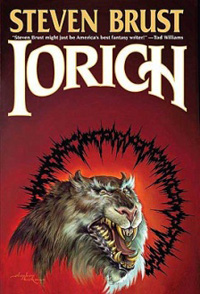Dragaera’s a really cool world, and the publication of Iorich in January will be the seventeenth book set there. Seventeen is a pretty significant number for the Dragaerans, and for Brust, so even though I did a post on the Vlad books when Jhegaala came out, that was ages ago and it seems like a good time to do some re-reading. Brust tends to write books with seventeen chapters, or double-length books with thirty-four. The Dragaerans have seventeen Houses, and a cycle that gives each House power in turn — though all the books are set when the House of the Phoenix is due to give way to the House of the Dragon real soon now.
Dragaera looks like fantasy but there’s no doubt in my mind that it’s science fiction underneath, even though there are sorcerers doing magic, witches doing witchcraft, and the occasional person who can manipulate the forces of chaos with his bare mind. (This goes spectacularly wrong sometimes. The Great Sea of Chaos and the Lesser Sea of Chaos, the one where the capital used to be, are evidence for that.) What gives it the science fictional underpinning is the detailed complicated backstory and the underlying axioms about how things work. You can argue about it, but there are aliens and genetic experiments. It’s at least as much science fiction as Lord of Light.
One of the things that makes Dragaera so real is that Brust has given us two different kinds of stories set there, which lets you triangulate on information in a way I really like. You get this with Cherryh too, but it’s unusual. It may also be what’s stopped Brust souring on the world and the series—there have been gaps between books, but he has kept them coming, seventeen books since 1983, as well as unrelated books. The series isn’t finished, but it is continuing pretty reliably, and there’s no sign that Brust’s tired of it.
No spoilers at all.
There are the Vlad books (Jhereg, Yendi, Teckla, Taltos, Phoenix. Athyra, Orca, Dragon, Jhegaala, Issola, Iorich) twelve of a projected nineteen. They tell story of an Easterner (human) assassin who lives in the underworld of the Dragaeran (elf) empire. Vlad’s all wiseass first person. He has a flying lizard (jhereg) familiar, Loiosh, who’s always making psionic wisecracks like “Can I eat him now, boss?” and “Two dead teckla on your pillow!” Vlad knows a lot about witchcraft, a lot about cooking, quite a bit about how House Jhereg runs its criminal activities, and a lot about how to kill people individually without getting caught. He’s less good on history, geography, the way the Empire works, and personal relationships. He has some powerful friends, including Morrolan, who has the only floating castle in the world these days. (That disaster that destroyed the capital stopped sorcery from working for a while, so everybody’s floating castles crashed. Talk about the bottom falling out of the housing market…) The Vlad books aren’t all entirely from Vlad’s point of view, Athyra‘s from the point of view of a Dragaeran boy he meets, and Orca alternates between Vlad and another very interesting other person. But mostly, we have Vlad telling the story of his life—and the question of who he’s telling it to and why has some interesting answers.
Then there are the Paarfi romances. Paarfi is a Dragaeran, which means he expects to live for at least a couple of thousand years. He’s writing historical romances set in his world, about real historical events and real people, much the way (and in the style) Dumas did in ours. The Paarfi romances (Five Hundred Years After, The Lord of Castle Black, and The Enchantress of Dzur Mountain aka The Lord of Castle Black, and The Enchantress of Dzur Mountain aka Sethra Lavode) are set years before the Vlad books, and deal with events that are backstory or history to Vlad. But some of the people, being Dragaerans, are still alive, and Vlad knows them well, whereas Paarfi is working from historical accounts. Paarfi’s good on getting titles and dates right, he understands how the Empire works, he’s also great at making up dialogue and motives. If Vlad and Paarfi contradict each other, for instance about the origins of the Interegnum, you have to consider that Vlad knows some of the participants well, but Paarfi will have looked things up. Vlad’s Morrolan’s friend, and knows some things about him Paarfi doesn’t know, but Paarfi’s researches might have dug up some information about him that he never mentioned to Vlad, because Vlad didn’t meet him until four hundred years after the events of Paarfi’s books.
These books are all great fun, good adventures, you don’t have to read them looking for background world clues. All the same, one of the things I love about them is the way you can absolutely trust that Brust knows what he’s doing, that his details add up, that he mentions a really good restaurant called Valabars a handful of times and finally takes you there in Dzur, that by the time you meet the Jenoine and the Serioli you have such a healthy curiosity about the hints dropped about them that you want to ring your friends and tell them there’s a Serioli! And it never falls flat. Brust pulls off bravura tricks of storytelling, revelations, secrets, backstory, complexities, and it’s never silly, never too much, never unbelievable. Although he’s been writing thse books since 1983 they are consistent in feel, almost never contradictory, and build up a solid world.
So, onwards to the individual volumes!
Jo Walton is a science fiction and fantasy writer. She’s published eight novels, most recently










